The Search for the Portrait that Belonged to Kittel Pages
at The Face Of Bach
The Queens College Lecture of March 21, 2001 - Page 11 - Why the Weydenhammer
Portrait Fragment is an Accurate Depiction of the Face of Johann Sebastian Bach
The Face Of Bach
This remarkable photograph is not a computer generated
composite; the original of the Weydenhammer Portrait Fragment, all that remains of the
portrait of Johann Sebastian Bach that belonged to his pupil Johann Christian Kittel, is
resting gently on the surface of the original of the 1748 Elias Gottlob Haussmann Portrait
of Johann Sebastian Bach.
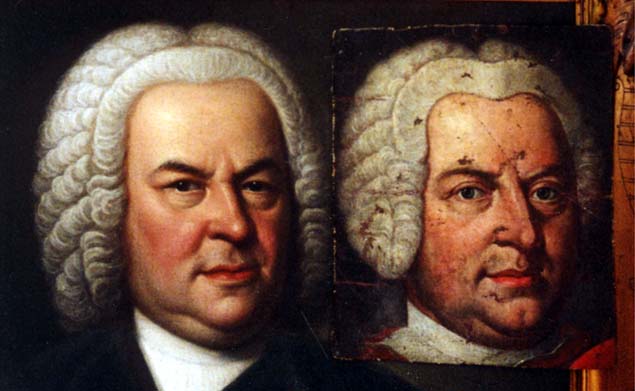
1748 Elias Gottlob Haussmann Portrait, Courtesy of William H. Scheide, Princeton, New Jersey
Weydenhammer Portrait Fragment, ca. 1733, Artist Unknown, Courtesy of the Weydenhammer
Descendants
Photograph by Teri Noel Towe
©Teri Noel Towe, 2001, All Rights Reserved
The Search for the Portrait that Belonged to Kittel
The Queens College Lecture of March 21, 2001
Page 11
Why the Weydenhammer Portrait Fragment is an Accurate Depiction
of the
Face of Johann Sebastian Bach
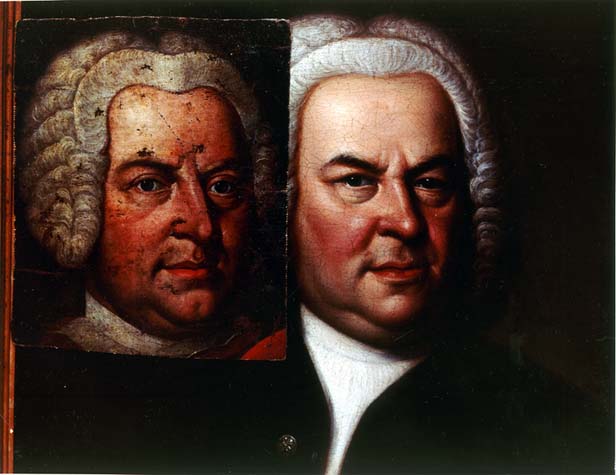
Photograph by Greg Kitchen, ©Teri Noel Towe, 2001
It may only be the third month of the first year of the third millennium
of the Christian era, but, as far as I am concerned, this photograph, which was taken on
January 18 of this year by Greg Kitchen, a professional photographer who specializes in
photographing oil paintings, is the photo of the century. The original of the Weydenhammer Portrait Fragment, is resting gently on the surface of
the original of the 1748 Haussmann portrait, thanks once again to
the kindness and the generosity of Bill Scheide. This is the image that you have on your
handouts, which are printouts of a digital scan of this incredible photograph. While the
details that I will show as we proceed through the comparison of the two paintings on
which I am about to embark are not taken from this same image, with one significant
exception, it nonetheless will allow you to analyze the two paintings on your own, using a
printout from a digital scan that is uniform throughout with respect to its color values.
I will now show, by direct comparison with the 1748
Haussmann portrait, the 1746 Haussmann Portrait, and, in one
instance, the photographs of Bach's skull, that (1) the face in the Weydenhammer
Portrait Fragment is that of Johann Sebastian Bach and (2) that the Weydenhammer Portrait Fragment is a portrait from life, and not
derived from any other image, known or unknown.
In all of these "side by side" comparisons, the Weydenhammer Portrait Fragment is the central example, the 1748 Haussmann portrait is the left hand or the upper example, and
the 1746 Haussmann portrait, in its unrestored state, is the
right hand or lower example. Unless I indicate otherwise, the details that follow are
derived from a magnificent 8x10 transparency of the Weydenhammer
Portrait Fragment that was commissioned by the Weydenhammer Descendants from Ken
Wagner of Seattle, Washington, a photograph that I took of the face of 1748 Haussmann portrait in Princeton this past November 9th, and the
photogravure of the unrestored 1746 Haussmann portrait that
appears as an illustration in the Bach Jahrbuch 1914.
Let me begin with some basic assumptions, a reminder, and some general
observations.
First, for the purposes of this comparison, I am assuming
(1) that the Weydenhammer Portrait Fragment is
what remains of the missing portrait of Bach that belonged to Kittel,
(2) that the portrait that belonged to Kittel in fact was
commissioned by Christian Duke of Sachsen-Querfurt-und-Weissenfels during the seven year
period, 1729 to 1736, while Bach was Christian's Capellmeister von Haus aus,
(3) that the portrait that belonged to Kittel was as it is
described by Hilgenfeldt, namely, "ein Brustbild, Bach im Staatskleide
darstellend", and
(4) that the original dimensions of the portrait that belonged to
Kittel were as given in the catalogue of the sale of Kittel's estate.
This set of assumptions means that I am about to demonstrate that the Weydenhammer Portrait Fragment depicts a Sebastian Bach who is a
minimum of ten years younger and a maximum of 19 years younger than the Bach of the Haussmann portraits. To demonstrate the implications of this
endeavour, let me recall The Father of Our Country to the arena.
Please remember throughout this demonstration that the George Washington
of the Athenaeum Portrait, at 64, was 16 years older than the George Washington whom Peale
painted for Elias Boudinot, and that the Bach of the 1748 Haussmann
portrait was 63, or 15 years older than the Bach of the Weydenhammer
Portrait Fragment would have been in 1733, the midpoint of his seven year tenure as Capellmeister
von Haus aus to Christian, Duke of Sachsen-Querfurt- und-Weissenfels. Merely
considering how much further advanced President Washington's drooping eyelids were in his
last full year in office than General Washington's were at the Battle of Princeton, and
how many more wrinkles and furrows can be seen in the President's face at 64 than are
evident in the General's at 48 should effectively underscore my point.
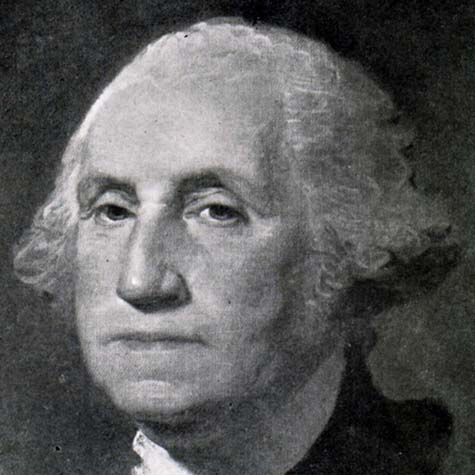
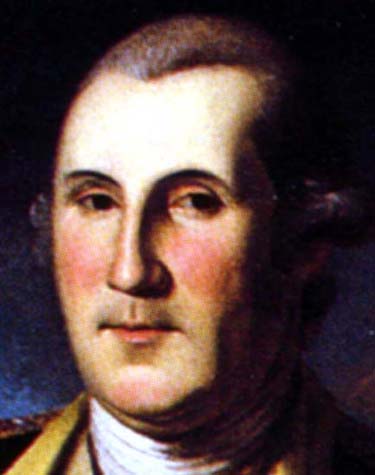
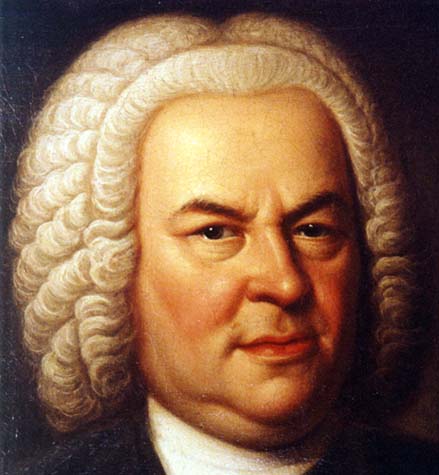
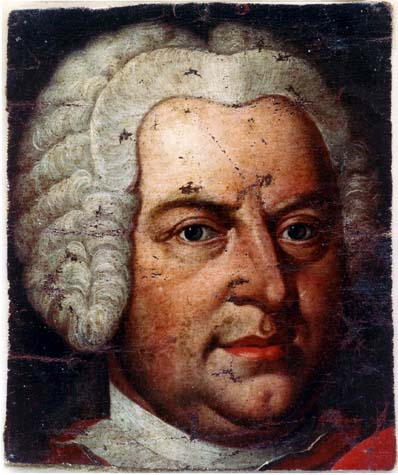
To put it in mathematical terms, Athenaeum is to Boudinot as 1748 Haussmann is to Weydenhammer Portrait
Fragment.
And now the general observations:


The image on the left is a detail from another photograph of the 1748 Haussmann portrait that I took in Princeton last November; this
detail is what I call a Weydenhammer Equivalent; the image on the right is the Ken Wagner
8x10 transparency of the Weydenhammer Portrait Fragment that was
commissioned by the Weydenhammer Descendants.
Please remember throughout that the Haussmann Bach is a significantly
heavier man than the Weydenhammer Bach. Two doctors with whom I discussed this facet of
the comparison confirmed the accuracy of my estimate that the body weight of the Haussmann
Bach was at least 25 to 30 pounds greater than that of the Weydenhammer Bach. Please note
that the Weydenhammer Bach has a neck that is clearly visible as it emerges from the
collar of the shirt and that the jowls, so to speak, have not obscured the neck in any
significant way. The Haussmann Bach, on the other hand, has no visible neck at all, and
the heavy jowls have completely obliterated the neck as it emerges from the collar of the
shirt. This enormous difference in weight has a significant impact on certain aspects of
Bach's facial features, as I shall explain later.
The increase in weight not withstanding, one aspect of the overall face
quickly can be shown to be the same in both paintings. You will recall that I pointed out
in the case of George Washington that there is a discernible "borderline"
between light and shadow on the left side of his face in the various "three
quarter" poses that have come down to us, and that it can be traced almost as though
an interstate highway on a road map. The same is true with Bach; the same "ins and
outs" of the borderline can be traced in both.
That the faces of the Haussmann portraits and
the Weydenhammer Portrait Fragment are identical, and that one is
a "younger" version of the other two, becomes even more apparent when one
studies just the faces, without the distractions of the perruques and the clothing. (Fear
not! I shall return to the issue of the perruque!)
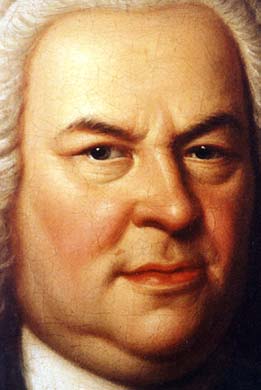


I realize, of course, that I am biased, but, nonetheless, I
cannot understand how anyone who studies these three details, side by side, could come
away with any conclusion other than the face in the center is a younger version of the
faces on the left and on the right.
Having enumerated and described the physiognomical
characteristics of Bach's face that must be taken into consideration in evaluating any
image that is claimed to depict accurately the face of Johann Sebastian Bach, let me now
compare these three faces, anatomical detail by anatomical detail, starting at the top and
working down. Descriptions that refer to "left" or "right", are from
Bach's perspective, not the viewer's, unless otherwise indicated.
First, the distinctive furrowed brow:



The same distinctive asymmetry is in evidence. In all three
paintings, the right brow meets the bridge of the nose almost exactly the same distance
above the point at which the left brow meets the nose. Furthermore, the distinctive upward
creases in the skin where the brows meet the bridge of the nose are evident in all three
paintings. That the angle of the right brow is not yet as acute as it is in the Haussmann
portraits is attributable, of course, to the difference in age; the same is true of the
ridges or furrows in the brow. Still the two primary ones are easy to discern in the Weydenhammer Portrait Fragment, the abrasion of the painting surface
notwithstanding. It is difficult, if not impossible, to make out even the beginnings of
the "extra" ridge over Bach's right eybrow through the grime and varnish, but,
if this wrinkle is not apparent after the painting has been carefully cleaned by Alain
Goldrach, its absence will be of no import; as we have seen there is strong evidence that
this wrinkle began to develop in later years, and therefore may not have begun to evidence
itself at the time that the Weydenhammer Portrait Fragment was
painted.
Next, the eyelids:



Once again, the simlarities are immediately apparent.
First, the beginnings of the fully developed ptosis
(or blepharochalasis) that is so much a hallmark of the Haussmann depiction of
Bach can be clearly seen. The right eyelid has begun to sag -- Please note the two
"folds" at the right end of that eye. -- and the first hints of the sagging can
be seen in the left lid. It is also telling that, in all three images, the development of
the ptosis in the left eye lags behind the development of the ptosis in
the right eye.
Second, please note the remarkable similarity between the
shapes of the lower right lids in all three paintings. There is a distinctive
"curve" just to the viewer's left of the point at which the lid meets the nose
that can be seen clearly in both the 1748 Haussmann and the Weydenhammer Portrait Fragment. Although it is a bit blurry in the
blown-up detail of the photo of the unrestored 1746 Haussmann,
this distinctive quirk is still clearly discernible. Additionally, the distinctive, and
very much different configuration of the left eye where it meets the nose is remarkably
similar in all three.
Before I address the issue of the color of the eyes, let me
point out that very subtle physiognomical characteristic to which I alluded earlier. This
characteristic is so subtle that neither Bill Scheide nor I had ever noticed it; it was
pointed out to us last December by the sound restoration engineer, Seth B. Winner, the
sonic magician who has been my partner in a series of historic reissues from 78s
to compact discs for more than a decade. Seth was with me on the second of the four
occasions on which the originals of the two paintings so far have been brought together.
He looked that the original of the Weydenhammer Portrait Fragment,
walked over and studied the 1748 Haussmann for a moment, turned
around and asked, "Bill, have you or Teri ever noticed that Bach was wall-eyed?"
Neither one of us had, but the misalignment, which is very subtle, is visible in all three
paintings. The right pupil and the left pupil are not exactly parallel, and Seth's
discovery is not illusory by any means; it has been confirmed by the two doctors whose
opinions I have solicited so far.
This subtle ocular peculiarity must be yet another
ramification of the fundamental asymmetry of Bach's eyes, and in this context it is
appropriate to point out once more the distinctly different shapes of the eyes, a
difference that is accurately depicted in the Haussmann Portraits
and the Weydenhammer Portrait Fragment.
This is as good a time as any to confront the issue of the
color of the pupils of Bach's eyes in the Weydenhammer Portrait
Fragment. When the originals of the two paintings met for the first time on December
8th of last year [2000], whether the eye colors would match was a matter of critical
importance. I was, of course, both relieved and elated to discover that the pupils in the Weydenhammer Portrait Fragment are the same steel blue grey color as
those in the 1748 Haussmann.
Here, from the Greg Kitchen photograph that you have on
your handout, is the detail showing the eyes, side by side. Any color correction that that
Michael V. Cohen of New York Film Works made during the scanning process was made
uniformly across the entire surface of the image.

Now, here is that image, divided, with the 1748 Haussmann on top of the Weydenhammer
Portrait Fragment; this initial juxtaposition shows the overlap of the two paintings:


And now here is that same juxtaposition,
"edited", so that the 1748 pair of eyes is directly over the WPF pair:


Not only is the eye color the same, but also that the
irises of Bach's pupils seem overly large, dilated, if you will, is also clearly apparent
in both paintings.
Next, let us have a look at the bags under Bach's eyes.



The 1746 Haussmann is of little
value because of its poor condition in this area, but, even so, one can make out the
distinctive semicircular curve that begins at the nose end of the right eye. The greater
detail to be found in both the Weydenhammer Portrait Fragment and
the 1748 Haussmann makes it possible to catalog to trace not only
that curve but also a couple of others, under the left eye.
Next, the nose:


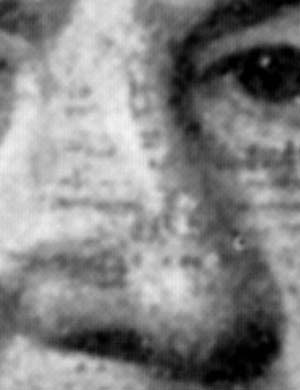
Once again, the similarities are immediately apparent. The
distinctive arch on the left side of the nose is seen in clearly in the details from the 1748 Haussmann and the Weydenhammer Portrait
Fragment, and, despite the abrasion of the canvas in the Weydenhammer
Portrait Fragment, the essential shape and flair of the right nostril are clearly the
same. The 1746 Haussmann, alas, has negligible probative value
because of the severe paint loss to the nose, especially the bridge.
Now, the mouth:
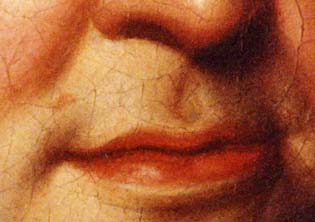

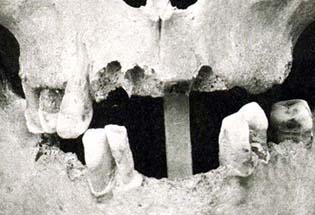

I have added a detail of the frontal photograph of the skull to aid in this comparison. I have also included the 1746 Haussmann, even though its probative value is minimal because
of all the surface damage and abrasion in this area. Once again, the similarities are
striking. The tight, deep creases where the lips meet the cheeks are identical, and the
lower jaw clearly extends beyond the upper in the Weydenhammer
Portrait Fragment, as it does in both of the Haussmann portraits and the skull.
To reinforce the point, here is a comparison of
"flopped" versions of the Weydenhammer Equivalent from the 1748
Haussmann Portrait and the Weydenhammer Portrait Fragment:

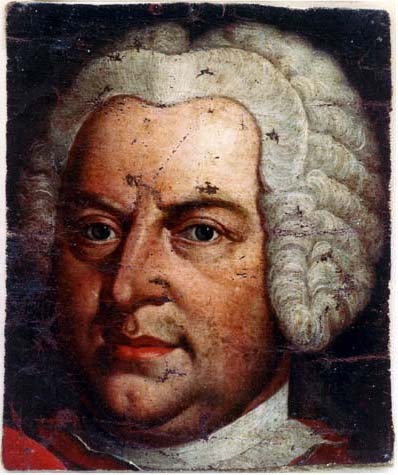
Shortly after I had some 8x10s made from that first
snapshot of the Weydenhammer Portrait Fragment last April, I went
to see my dentist, Spiro Balaouras. At the time, I was reading Christoph Wolff's superb
new biography, Johann
Sebastian Bach, The Learned Musician (W. W. Norton, New York, 2000), which, I
remind you, has a close up of the head of the 1748 Haussmann Portrait
on the dust jacket. After the prophylaxis had been completed, I asked my dentist if he
would give me his opinion and tell me if he thought the mouth and jaws of the Weydenhammer Portrait Bach and the mouth and jaws of the 1748 Haussmann Portrait Bach were those of the same man. I put a
framed 8x10 down on the counter and the Wolff biography beside it.

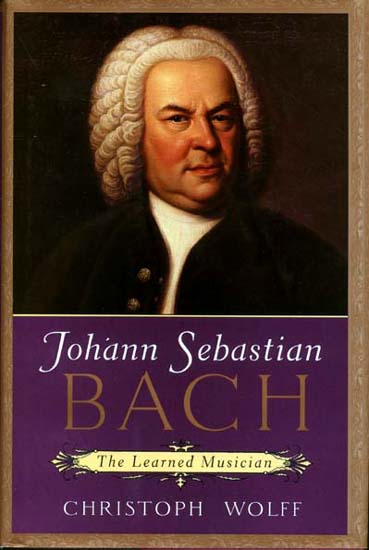
He examined the two faces, pointed out the many identical
features, and agreed with me that it is the same jaw and the same mouth.
Subsequently, as you already know, Spiro and I had an
extended discussion about Bach's detention, with the benefit of the additional evidence
that the photographs of the skull provide. Not only does Spiro
continue to agree with me that the jaws are those of the same man but also he confirms my
contention that the firmer appearance of the lips in the Weydenhammer
Portrait Fragment is a direct reflection of the reality that Bach had more teeth in
his jaws when he sat for the as yet unidentified limner who painted the Weydenhammer Portrait Fragment than he did a decade and more later
when he sat for Haussmann.
We know from Alain Goldrach's examination of the original
of the Weydenhammer Portrait Fragment that what appears to be a
birthmark on the upper right lip is dirty varnish and not the same small blemish that one
can see almost directly above the end of the lip in the 1748
Haussmann portrait. (This tiny mark, which is clearly original, has often been
erroneously "air brushed" out of photographic reproductions of the 1748 Haussmann portrait, and it is long gone from the much
restored 1746 Haussmann portrait, if it ever was there.) The
absence of the blemish from the Weydenhammer Portrait Fragment
could be a manifestation of the Stridex® Factor, but it is more likely that the blemish
that one sees on the 1748 Haussmann Portrait (and the "black
light" examination that Bill Scheide and I made of the painting indicated that this
blemish is not later overpaint) is what my grandmother used to decorously call an
"age spot", but it also could be a basal cell skin carcinoma.
Since, mercifully, no one has ever attempted to
"restore" and "in paint" the Weydenhammer
Portrait Fragment, those of us who study it do not have to worry, as one must with the 1746 Haussmann portrait, about how much has been obliterated in
the process of restoration or about trying to sort out which brushstrokes are original and
which are not. However, to quote my father, "What you make
on the bananas, you lose on the peanuts." As we know, the surface of the Weydenhammer Portrait Fragment not only has suffered some paint loss
but also is speckled and spotted in several areas with dirty and discolored varnish. The
combination of the abrasions to the canvass's surface and some spots of dirty varnish
fortuitously enhance what appears to be the one major anomaly in the Weydenhammer
Portrait Fragment, the chin dimple.
Let's compare the whole lower jaw:
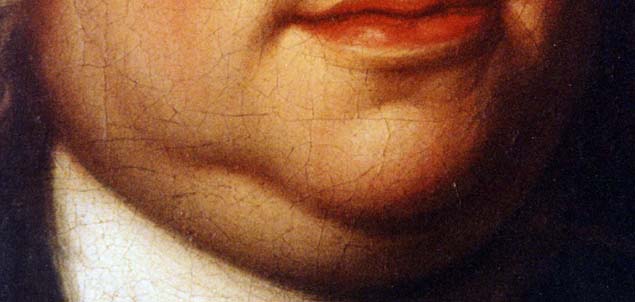
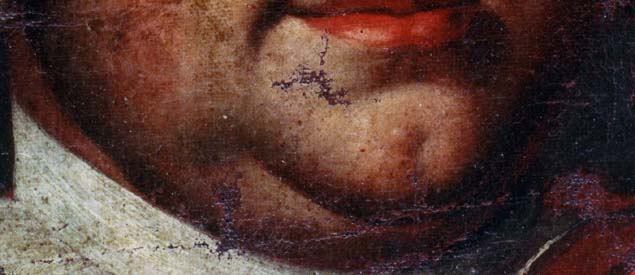

It does not take much effort to see just how much heavier
Bach was when he sat for Haussmann, in both 1746 and 1748, than he was when he sat for the Weydenhammer Limner. As I
remarked earlier, two different doctors have confirmed the accuracy of my estimation that
there was an increase in overall body weight of at least 25 to 30 pounds, more than enough
to "fill in" a shallow chin dimple with subcutaneous fat. But, even if that is
not enough weight, we still have the Stridex® Factor with which to contend. Bach paid for
the Haussmann portraits and therefore could, and clearly did,
control the form and substance of the image; Christian von Sachsen
Querfurt-und-Weissenfels paid for the Weydenhammer Portrait Fragment,
and, clearly, he determined what the form and substance of the image were to be.
But, is there any evidence, no matter how tenuous, to
support the contention that Bach had that shallow dimple or cleft in his chin? Once again,
I shall invoke the Mendel Principle, albeit by bending it a teeny-tiny bit. I am not
alone, by any means, as a student of the Bach iconography, and there are others who share
my carefully considered conviction that the Meiningen Pastel is
genuine. So, let's see what happens when we put it beside the Weydenhammer
Portrait Fragment and the 1748 Haussmann Portrait. In this
next comparison, the Meiningen Pastel replaces the 1746 Haussmann Portrait as the right hand example.


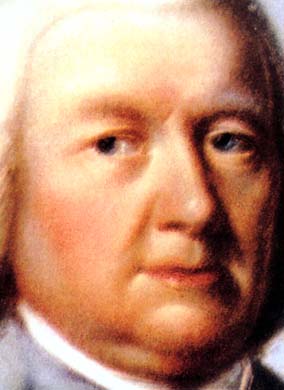
Time limitations prevent me from explaining why it is that
I am convinced that the Meiningen Pastel is an authentic
portrait from life of Johann Sebastian Bach, but, for the present, suffice it to say that
I believe that it dates from about midway between the Weydenhammer
Portrait Fragment and the 1748 Haussmann Portrait. The image
also shows weight gain, but that gain is somewhat less than that in evidence in the 1748 Haussmann Portrait. The Meiningen Pastel
is also, I remind you, diminutive in size and, because it is a pastel, perforce, not as
crisp in detail. Nonetheless, a strong case can be made for the presence of the hint of a
chin dimple at precisely the correct spot.
Please click on 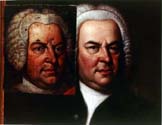 to advance to Page 12.
to advance to Page 12.
Please click on  to return to the Index Page at The Face Of Bach.
to return to the Index Page at The Face Of Bach.
Please click on  to visit the
Johann Sebastian Bach Index Page at Teri Noel Towe's Homepages.
to visit the
Johann Sebastian Bach Index Page at Teri Noel Towe's Homepages.
Please click on the 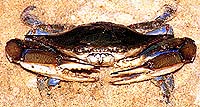 to visit the
Teri Noel Towe Welcome Page.
to visit the
Teri Noel Towe Welcome Page.
TheFaceOfBach@aol.com
Copyright, Teri Noel Towe, 2000 , 2002
Unless otherwise credited, all images of the Weydenhammer Portrait: Copyright, The
Weydenhammer Descendants, 2000
All Rights Reserved
The Face Of Bach is a PPP Free Early Music
website.

The Face Of Bach has received the HIP Woolly Mammoth Stamp of Approval from The HIP-ocrisy Home Page.